His cries of ‘spice, spice’ herald new beginnings, but at only 4 years old…this little man knows it not. This is the first proper ‘thing’ to come out of our new kitchen ( long before our delicious churros which have been followed by cupcakes and pizza. I’m thankful I can still cook and bake!), or ‘shrine’ as my younger sister calls it. It could pass for one. Small, and walls bedecked with ‘oddities’ that might look like instruments of war…to the uninitiated – roasting needles, an old ice-cream scoop, whisks and a metal jug that some may consider fit for a rubbish heap. Not me.
And though he says spice, this is not on the level of any Indian curry. He pinches his nostrils together, but not in dislike for the spices, me thinks but rather a force of habit which I will gently help him overcome. With pungent Nigerian soups, he does this same….but will also eat them. This stew is no exception. I surmise that it is the unfamiliar, near-forgotten scents that prompt this behavior.
To be honest, I wondered if the stew would be tasty, cooked in pots of old….. on a stove fresh and new as day. This ‘stew’ came out more than ‘just fine’.
Nigerian Food 101: There is a trinity of dishes in Nigeria = soups, stews and starches (grains and pastes/purees)
The world is full of the best of stews – every cuisine has its stalwarts. The Irish call their boozy beef dish ‘Irish stew’, Moroccans cook theirs in tagines, terracotta pots that also lend their name to the dish and Hungarians go wild with paprikash – flavoured with paprika powder and best eaten with Tarhonya, an egg barley pasta which is the Hungarian equivalent of couscous, albeit with larger grains.
In Nigeria and to Nigerians, when you say ‘stew’ – you can only mean one thing: a ‘red’ aromatic dish, made with pureed tomatoes, red onions, and chilli pepper, fried in some oil. That’s stew. Everything else likely falls into the ‘soup’ or sauce category. It is a staple. Known far and wide, in every nook, cranny, creek and grassland of this land.
One of its closest, foreign culinary cousins is a version of ragu from Italia – think chunky rib, beef and pork stews.
In Nigeria, you’ll find ‘stews’ everywhere, in every kitchen – roadside, street corner, palace…a constant in the deep freezers of working mothers (like me), a staple on every Nigerian restaurant menu card. Why? Its versatility. It is an accompaniment that makes an easy meal.
Bread for breakfast, preferably soft, white bread? Pair it with some stew. Lunch or dinner of rice, beans, yams, potatoes, plantains? See what stew can bring to the table. It even lends itself in service to ‘soups’, accompanying them on journeys where they aren’t just passengers. Take okro for instance; sometimes, it is simply grated, and cooked briefly with some water, a pinch of salt and other light seasonings. And then it is served with some stew.
Want to make ‘emergency’ Jollof rice? Left-over stew can come to your aid.
So what’s so ‘hot’ about this stew? First of all – it is made with fresh ingredients. In Nigeria, markets are the order of the day and are as popular and common as supermarkets. Every locale/community will have a small market, full of haphazard zinc-roofed stalls held high by steel or wooden rods, and full of food products and produce, retailed in quantities that most people can afford. Pyramids of plum and beef tomatoes are a common sight, arranged by size and price.
It is far cheaper to buy fresh tomatoes here, compared with tinned/canned and so we always go for fresh. I remember the first time I grasped the ‘organic’ concept. I was abroad and perplexed – what was the big deal? We ate organic in Nigeria (a developing country) so how difficult would that be in Europe (a developed country)? This was long before I understood the science behind genetically modified foods, the challenges of managing land use especially for agriculture, trade agreements, the reliance of countries on exports and the myriad of other things that affect what is set on plates before us.
Point being that though a developing nation, we eat closer to nature because canned/imported fruit and vegetables are far costlier than buying fresh. It’s interesting that when I sit in my kitchen, caressing a tomato or an apple in warm hands, I don’t see the journey this piece of fruit or vegetable has been on. The struggle its endured and just how much people’s livelihoods depend on me holding it my hand.
One of my favourite meals growing up was to have ‘bread and stew’. And so my heart fills with pride when my pot of stew is ‘done’ and my kids come clamoring for some.
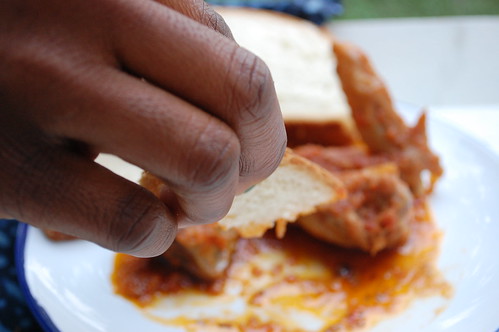
It is often called Nigerian tomato stew or Nigerian red stew to reflect the ingredient or the look of the stew.
There are endless variations when it comes to cooking up a pot of stew. Some of the most common elements to vary are:
Cooking style/result
- People begin and end the cooking of stews in different ways: some pre-cook the tomato mixture prior to making the stew (I prefer to do this), while others cook the tomato mixture with the meat/fish.
- Some people prefer a thick, ‘fried’ stew (that’s my camp) and others like a thin, liquid sauce. As a result, cooking times will vary
Ingredients
- Proportions of tomatoes, red onions and chilli pepper – some people prefer more onions than tomatoes, and vice versa
- Cooking oil – there is a difference in the taste profile when vegetable oils are used, versus (red) palm oil; some people use olive oil and coconut oil but vegetable oils (sunflower etc.) are more common.
- Spice combinations – the most common spice profile is a mixture of curry powder (not Indian curry powder but similar to Caribbean curry powders), dried thyme with garlic and ginger (fresh or in powdered form).
- Protein – everything goes from beef, to chicken, fish and offal, and all the permutations in between. Each man to his own. I often make a combination of chicken and beef; occasionally, I make seafood stews, with Tilapia and tiger prawns and lot of chilli pepper.
- Greens like spinach, pumpkin leaves, water leaf and others are sliced and then added towards the tail end of cooking to yield a vegetable stew
—–♥♥♥—–
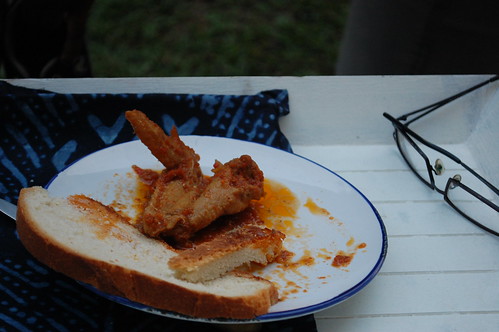
Notes/Tips
- In Nigeria, red/purple onions are common and are almost always the alliums of choice when cooking. White onions are more expensive and are typically used in salads
- When pureeing the tomato mixture, let it remain a touch chunky – a smooth mixture will take longer to cook and will not yield the ‘fried’ look and texture that I deem hip in the finest of stews.
- You could always scoop out the excess oil and use as a flavouring in other dishes.
- Adjust the taste to suit your needs and palette – sometimes, I add ground cumin to the spice list and that lends a smoky sweetness. Coriander powder, Garam masala….all would work well to give a nice, non-traditional twist to the flavor profile
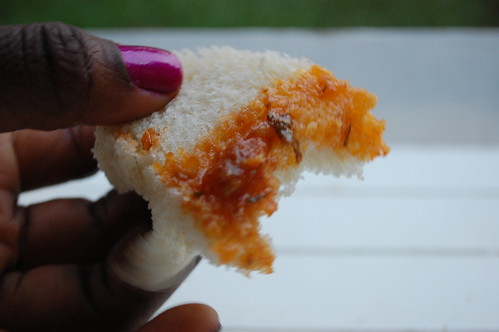
Nigerian Tomato Stew
Makes a large pot, but can be scaled up and down to suit needs and preferences
Ingredients
Tomatoes – 1 kg of fresh tomatoes, or two (2) 400g tins Red onions – 4 to 6 medium onions (3 – 4 peeled and roughly chopped; 1-2, peeled and finely chopped or thinly sliced) Chili pepper, to taste 2 fresh ‘soup’ chickens, cut up; or chicken parts about 3kg 500g stewing steak/beef, cut into chunks 1 teaspoon (smoked) paprika powder, extra for cooking meat 1/2 teaspoon turmeric powder, extra for cooking meat 1/2 teaspoon ground black pepper, extra for cooking meat 1 tablespoon curry powder (or to taste), extra for cooking meat 1 teaspoon dried thyme (or to taste), extra for cooking meat 1 teaspoon garlic powder (or to taste), extra for cooking meat 1 teaspoon ginger powder (or to taste), extra for cooking meat 1 – 2 tablespoons of tomato paste Salt, to taste Vegetable oilPreparation
I follow a three-step approach in making my stews:
- Preparing the tomato mixture – I almost always pre-cook/reduce my tomato mixture to rid it off the harsh edges and smoothen out the flavours
- Steaming the meat
- Finishing the stew
Important notes
- The spices listed in the ingredients are for the stew – not the meat.
- You can halve the quantities for the tomato mix and the meat. Spices – adjust according to your taste
Preparing the tomato mixture
Puree tomatoes with the roughly chopped onions and add some chilli pepper, if using. Pulse till you get a mixed up by somewhat chunky texture. Hard to describe…. it should be well blended but not ‘passata’ smooth.
Put the mixture in a large pot and cook on medium to low heat, till reduced by about a third.
Steaming the meat
While the tomato mixture is cooking, cook the chicken and beef in a mixture of your favourite spices (curry powder, dried thyme or oregano, etc.), with half of the sliced onions – reserve the other half.
Bring to the boil on medium heat, then turn down and simmer till meat is just almost cooked. If you cook the meat till it is soft, it is likely to fall apart in the last stage of cooking.
Remove from heat and reserve meat and cooking liquids.
Finishing the stew
In a large pot, pour a couple of cooking spoons of vegetable oil, about 1/2 – 1 cup. Add the remaining sliced onions and all the spices and fry with a pinch of salt till the onions soften about 5 minutes.
Add the tomato paste and continue to stir – 2 to 3 minutes till the onions are coated in the tomato paste.
Add the cooked tomato mixture, some of the stock and the meat.
Stir, and bring to the boil. Then turn down heat, taste and adjust seasonings.
Allow the stew to simmer, (times will vary) till the cooking oil floats to the top. If the stew is still watery cook down some more, if too thick, adjust by adding stock.
When it is ready, serve with whatever your heart desires. Note that like most stews, it benefits from a day’s rest and is much better flavoured on day 2.
Note though, some are not gifted with patience.
Guilty if, and only if charged.
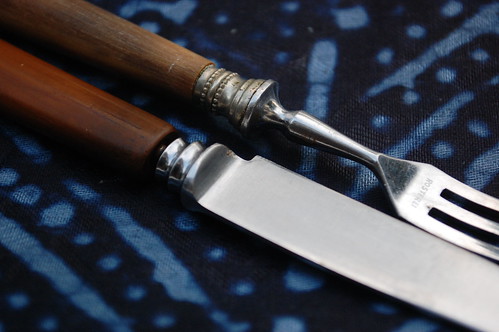

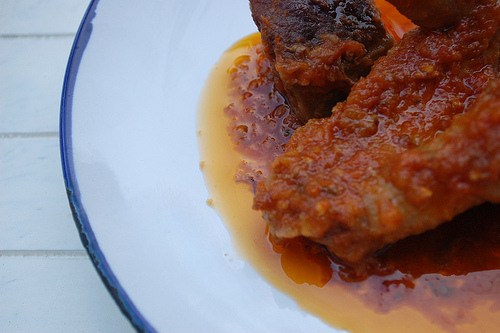

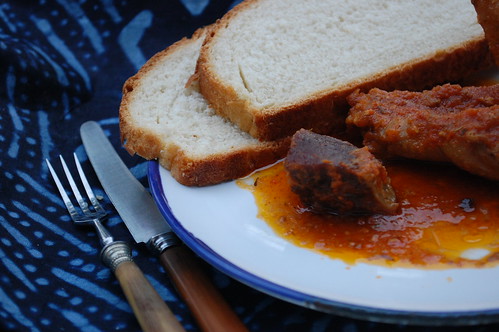
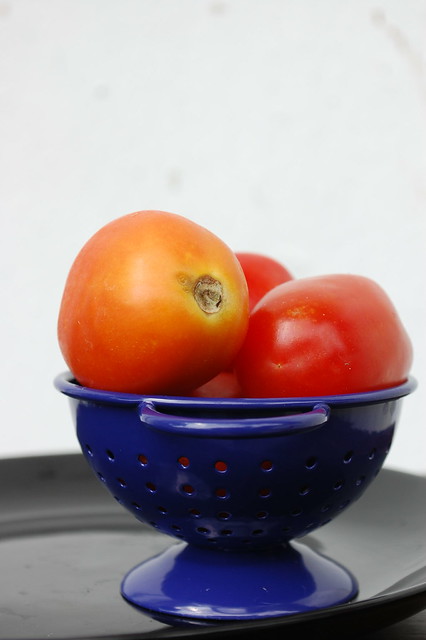
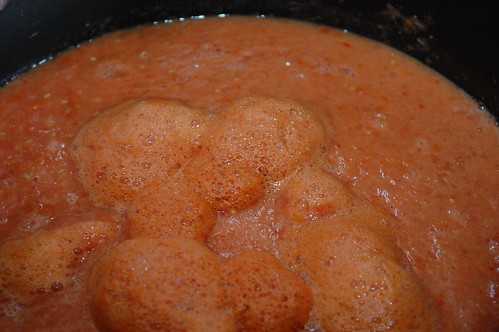
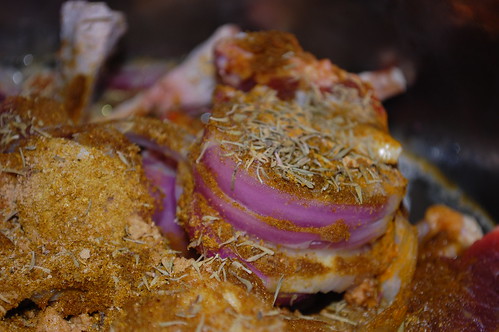
Leave a Reply